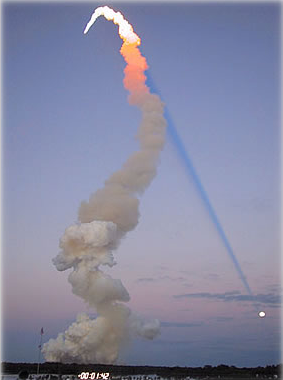Rocket plume shadow
Rocket Plume Shadow: An Enigmatic Atmospheric Phenomenon
Rocket launches are awe-inspiring events that captivate the imagination of people around the world. As the rocket propels itself into the sky, it leaves behind a trail of exhaust plume. Interestingly, this plume casts a remarkably long shadow, creating a visually intriguing spectacle. In this article, we will delve into the enigmatic phenomenon of the rocket plume shadow and explore its underlying mechanisms.
When observing the rocket plume shadow, one might initially find its direction and shape perplexing. However, a closer examination reveals the fascinating interplay between sunlight, the Earth's atmosphere, and celestial bodies. At the moment of observation, the sun has already set on the ground, positioning itself approximately 6 degrees below the horizon. Meanwhile, miles above the Earth's surface, the space shuttle and its plume emerge into direct sunlight, causing their shadow to stretch through the atmosphere.
As the rocket plume shadow extends farther from the camera, it undergoes two distinct transformations. Firstly, due to perspective, the shadow gradually narrows, creating a tapering effect. This phenomenon occurs because objects appear smaller as they move away from the observer. Secondly, the dark umbral part of the shadow tapers away physically. This is attributed to the nature of sunlight, which is not a point source but rather an extended source of light. Consequently, as the shadow moves away from its origin, it becomes less dense and gradually dissipates.
Curiously, the rocket plume shadow seems to point towards a bright object in the sky. To unravel this mystery, we need to consider the camera's orientation during the observation. In this particular case, the camera is facing northeast, capturing a captivating alignment. The recently risen Moon, positioned approximately 9 degrees above the horizon, plays a crucial role in this phenomenon. Being within a few hours of reaching full phase, the Moon acts as a reference point known as the antisolar point. This is the point in the sky opposite to the position of the Sun. Consequently, all shadows cast by the sunlight align towards this point, including the rocket plume shadow.
The occurrence of rocket plume shadows is not limited to Earth's atmosphere alone. In fact, similar phenomena have been observed in the stratosphere and mesosphere. These regions of the atmosphere, located above the troposphere where weather occurs, provide an optimal environment for studying atmospheric optics. By analyzing rocket plume shadows at different altitudes, scientists can gain valuable insights into the behavior of light and shadow within Earth's atmosphere.
In conclusion, the rocket plume shadow is a captivating atmospheric phenomenon that occurs during rocket launches. As the rocket propels itself into sunlight, its exhaust plume casts a long shadow that narrows and tapers as it extends through the atmosphere. The alignment of the shadow towards the antisolar point, often marked by the Moon, adds an intriguing element to this spectacle. By studying rocket plume shadows in various atmospheric regions, scientists continue to deepen their understanding of the interplay between light, shadow, and celestial bodies. So, the next time you witness a rocket launch, take a moment to appreciate the mesmerizing dance of shadows in the sky.

The space shuttle Atlantis climbs upwards to orbit from pad 39A at 18.32 EST Feb 7, 2001, Mission STS-102. Imaged by Pat McCracken, NASA.
The sunlit exhaust plume casts an immensely long shadow. At first sight its direction and shape are enigmatic.
On the ground, the sun has already set and is 6� below the horizon. Miles above, the shuttle and its plume have broken out into sunlight and their shadow stretches through the atmosphere. It narrows due to perspective as it extends farther and farther from the camera. Its dark umbral part also physically tapers away because the sun is an extended rather than point source of light.
And the bright object it apparently points to? The camera looks north eastwards and the recently risen Moon is 9� high. The Moon is within a few hours of full and roughly marks the antisolar point to which all sun shadows aim.
Rocket trails in the stratosphere & mesosphere here.
Note: this article has been automatically converted from the old site and may not appear as intended. You can find the original article here.
Reference Atmospheric Optics
If you use any of the definitions, information, or data presented on Atmospheric Optics, please copy the link or reference below to properly credit us as the reference source. Thank you!
-
<a href="https://atoptics.co.uk/blog/rocket-plume-shadow/">Rocket plume shadow</a>
-
"Rocket plume shadow". Atmospheric Optics. Accessed on December 22, 2024. https://atoptics.co.uk/blog/rocket-plume-shadow/.
-
"Rocket plume shadow". Atmospheric Optics, https://atoptics.co.uk/blog/rocket-plume-shadow/. Accessed 22 December, 2024
-
Rocket plume shadow. Atmospheric Optics. Retrieved from https://atoptics.co.uk/blog/rocket-plume-shadow/.